Content
Tomato Black Elephant is one of the representatives of exotic varieties that amaze with their appearance. Gardeners prefer culture not only because of the beauty of the fruit, but also the taste of tomatoes.
Breeding history
In 1998, the originator of the variety, Gisok, applied for a new variety - the Black Elephant tomatoes. Since 2000, the culture has been registered in the Register and allowed to grow on the territory of Russia.
The variety was obtained empirically by crossing wild tomatoes with ordinary grown gardeners.
Description of the variety of tomato Black Elephant
The variety is indeterminate, capable of growing throughout the season. More often the bush is semi-spreading, reaching a height of 1.4-1.5 m.
The leaf plates are large, dark green in color, outwardly reminiscent of potato leaves. The first inflorescences are formed above 8-9 leaves, and then every 3 leaves.
Tall shoots need to be formed and tied, since under the weight of the fruit they can break or bend to the ground. Tomato Black elephant is recommended to regularly pinch, lead in 2 stems.
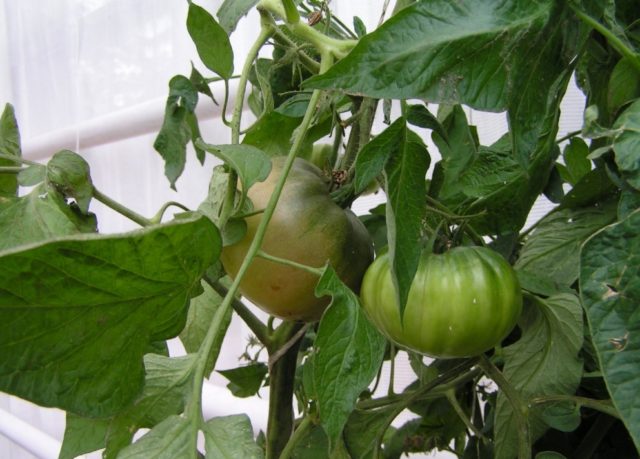
Fruit formation begins 105-115 days after sowing raw materials for seedlings
Description of fruits
The shape of the fruit of the Black Elephant variety is flat-round with strong ribbing. The skin is dense, at first green, but as it ripens, it turns red and then reddish-brown. A dark shade predominates at the stalk.
The pulp inside is juicy, fleshy, red in color. In the seed chambers, the shade is brownish brown with green. The taste of the vegetable is sweet, there is practically no sourness. From the photo of the Black Elephant tomato, one can appreciate the attractiveness of the harvested crop, but a pleasant pronounced aroma is also characteristic of the fruits.

The weight of each fruit varies from 100 to 400 g
Characteristics of the black elephant tomato
Tomatoes can be grown in any region of Russia, but in most of them it will be necessary to install a greenhouse. Without shelter, the Black Elephant tomato is cultivated in the Rostov Region, Krasnodar Territory, the North Caucasus and other areas with a warm climate.
The yield of the tomato Black elephant and what affects it
The variety is usually referred to as high-yielding. In unprotected ground from 1 m2 you can collect up to 12-15 kg of fruits. The average yield from 1 bush from an open bed is 4-5 kg.
In greenhouse conditions, it is possible to collect up to 15-20 kg from 1 m2... From 1 bush, the yield is 5-7 kg.
To obtain the maximum possible fruiting values, it is not enough to transfer the tomato to the greenhouse. The black elephant negatively affects the yield of the tomato Black elephant refusal to form and pinch, lack of dressing and support.

The more the gardener leaves the main stems, the smaller the fruits will be.
Disease and pest resistance
The tomato does not have a strong immune system. The plant does not tolerate excess moisture, therefore it is prone to late blight and rot. This feature is associated with a long ripening period, and with excessive watering of the Black Elephant variety without subsequent airing of the greenhouse.
Fusarium on tomatoes is often recognized at the height of the disease, mistakenly suggesting a lack of feeding. Starting from the lower leaf plates, yellowing of the foliage, gradual wilting and twisting can be noted, on the roots there is a white bloom. If you cut the stem, the "vessels" will be brown.
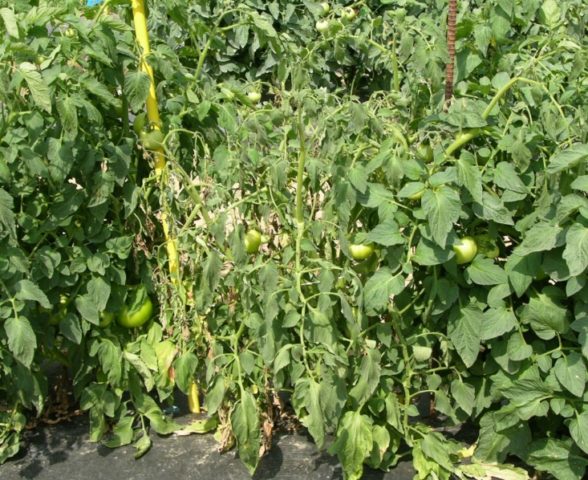
Often the height of the disease occurs during the period of flowering or ovary formation.
Rot is characterized by the appearance of white or brownish spots on the plant and discoloration of the fruit.
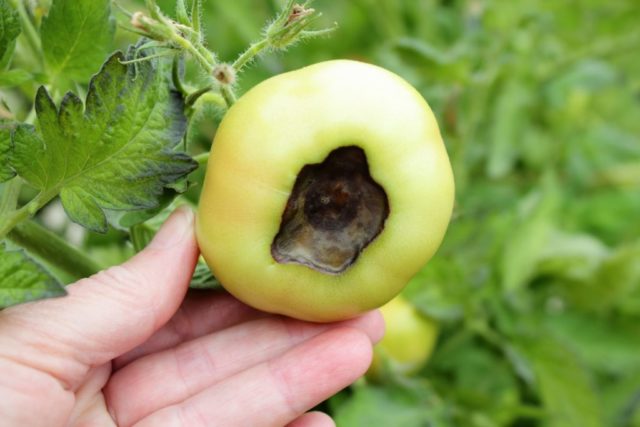
Rotted tomatoes Black elephant deform, turn brown, fall off the branch
Among the pests there is a risk of attack by the Colorado potato beetle, aphids, slugs and whiteflies.
Scope of the fruit
The main purpose of the variety is salads. In addition to being added to various dishes, medium-sized fruits are suitable for whole fruit canning. Delicious juices and ketchups are obtained from tomatoes. And although tomatoes are transportable, they do not have a high keeping quality, it is only 1-2 weeks.
Advantages and disadvantages
The variety attracts the attention of gardeners with its unusual decorative appearance. But tomatoes are also valued for their taste, high content of nutrients.
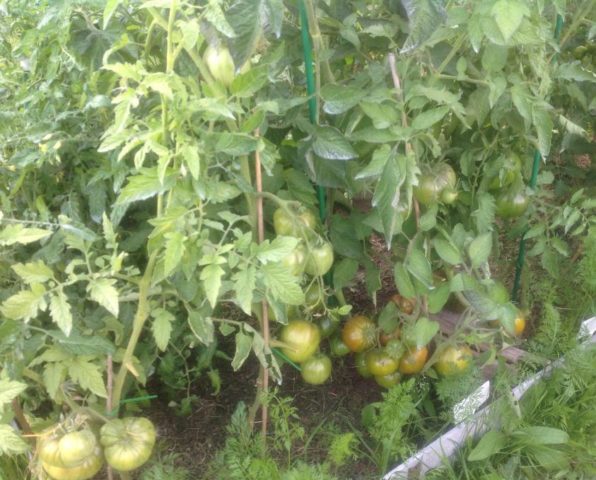
The advantage of the variety is also abundant, long-term fruiting, which allows you to feast on fruits throughout the season.
The advantages of tomatoes:
- the plant grows successfully both in open ground and under cover;
- the fruits contain a high content of substances useful for the body;
- exotic look.
Disadvantages of culture:
- low immunity to late blight;
- the need for shaping, garters;
- poor keeping quality.
Features of planting and care
Planting begins with sowing seedlings. All raw materials are treated with a manganese solution and a growth stimulator, containers are washed, ventilation holes are made.
The soil is prepared in advance by mixing the soil from the garden with ash and compost. To make the soil mixture looser, it is recommended to add sand or peat. As a replacement, you can use a primer from the store.
Sowing is carried out in early March, if it is planned to cultivate the variety in a greenhouse, and at the end of March, if the black elephant tomato is grown in the open field.
Sowing:
- pour earth into the box;
- moisten the soil and make rows with a distance of 1.5-2 cm;
- sow raw materials, cover the top of the container with foil.
Care during this period consists in airing the seedlings and watering, providing sufficient lighting.

As soon as shoots appear, the cover must be removed from the container.
The appearance of 2-3 true leaves is a signal for picking seedlings in separate containers. Further care consists in watering and feeding. 2 weeks before transplanting seedlings to a permanent place of residence, they should be taken outside for hardening.
1 m2 it is allowed to place up to 3 bushes. The distance between each of the plants should be at least 50 cm.
It is recommended to apply lime or organic fertilizers to the dug holes. Seedlings aged 50-60 days are best transplanted in the evening. To do this, the bush is taken out of the pot along with a lump of earth, put in a hole, covered with earth and watered abundantly.
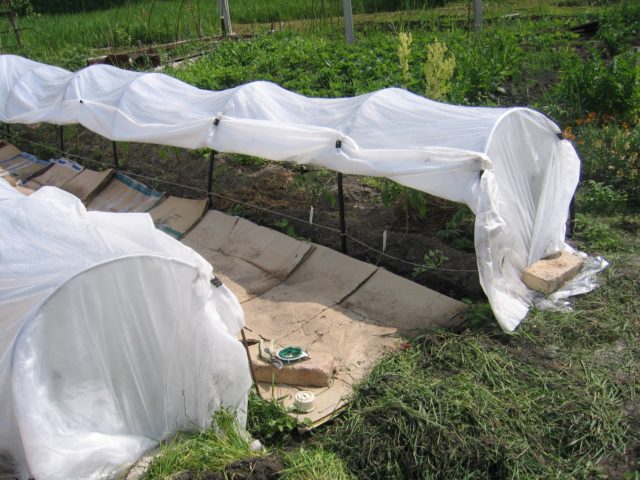
It is recommended to cover the Black Elephant tomatoes with material immediately after planting to help the plants adapt
Caring for a tomato includes the following steps:
- watering as needed;
- loosening followed by mulching;
- support organization or garter.
Throughout the season, the stepsons of the tomato Black elephant must be removed, the tomato itself must be formed into 2 stems. You need to tie up a seedling with a height of 80-100 cm.
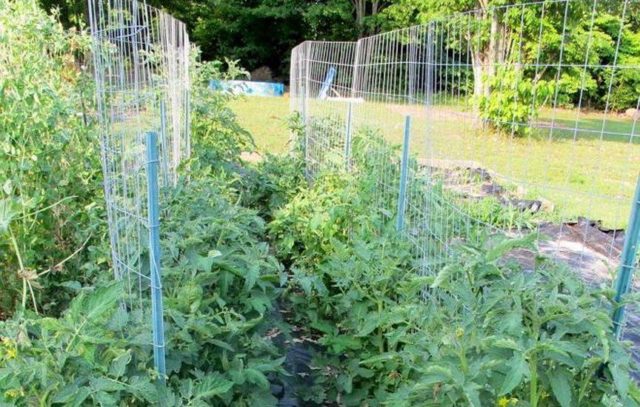
It is recommended to build a trellis as a support or use metal stakes.
There are no peculiarities in applying top dressing: the first fertilizers should be added to the soil 2-3 weeks after planting, then provided with useful substances every 5-7 days. If the Black Elephant tomato is grown in a greenhouse, then it is enough to feed it once every 10 days. As fertilizers, you can use both complex mineral and organic mixtures.
Pest and disease control methods
Even before transferring seedlings to open ground, it is recommended to prophylactically treat the plants with any fungicide: Topaz, Profit, Fundazol.
For insects, you can use insecticides such as Aktara, Karate, Fufanon.

The treatment of the bushes should be carried out according to the instructions, from the leeward side, using personal protective equipment, irrigating the bushes with a spray bottle
If signs of the disease are detected, it is necessary to remove all damaged parts of the plant, treat the bushes with the drug. Loosen the soil around them, ventilate the room if the culture grows in a greenhouse.
Conclusion
Tomato Black Elephant can be grown in any region of Russia. The variety is indeterminate, large-fruited, with abundant fruiting. The plant is demanding on moisture, it has a weak resistance to late blight. Fruits are sweet, sour, have a greater amount of nutrients compared to other varieties of tomatoes.








